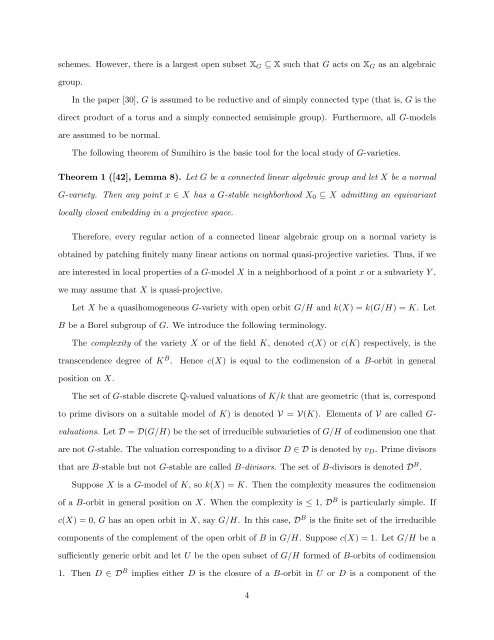Equivariant Embeddings of Algebraic Groups
Equivariant Embeddings of Algebraic Groups
Equivariant Embeddings of Algebraic Groups
You also want an ePaper? Increase the reach of your titles
YUMPU automatically turns print PDFs into web optimized ePapers that Google loves.
schemes. However, there is a largest open subset X G ⊆ X such that G acts on X G as an algebraic<br />
group.<br />
In the paper [30], G is assumed to be reductive and <strong>of</strong> simply connected type (that is, G is the<br />
direct product <strong>of</strong> a torus and a simply connected semisimple group). Furthermore, all G-models<br />
are assumed to be normal.<br />
The following theorem <strong>of</strong> Sumihiro is the basic tool for the local study <strong>of</strong> G-varieties.<br />
Theorem 1 ([42], Lemma 8). Let G be a connected linear algebraic group and let X be a normal<br />
G-variety. Then any point x ∈ X has a G-stable neighborhood X 0 ⊆ X admitting an equivariant<br />
locally closed embedding in a projective space.<br />
Therefore, every regular action <strong>of</strong> a connected linear algebraic group on a normal variety is<br />
obtained by patching finitely many linear actions on normal quasi-projective varieties. Thus, if we<br />
are interested in local properties <strong>of</strong> a G-model X in a neighborhood <strong>of</strong> a point x or a subvariety Y ,<br />
we may assume that X is quasi-projective.<br />
Let X be a quasihomogeneous G-variety with open orbit G/H and k(X) = k(G/H) = K. Let<br />
B be a Borel subgroup <strong>of</strong> G. We introduce the following terminology.<br />
The complexity <strong>of</strong> the variety X or <strong>of</strong> the field K, denoted c(X) or c(K) respectively, is the<br />
transcendence degree <strong>of</strong> K B .<br />
Hence c(X) is equal to the codimension <strong>of</strong> a B-orbit in general<br />
position on X.<br />
The set <strong>of</strong> G-stable discrete Q-valued valuations <strong>of</strong> K/k that are geometric (that is, correspond<br />
to prime divisors on a suitable model <strong>of</strong> K) is denoted V = V(K). Elements <strong>of</strong> V are called G-<br />
valuations. Let D = D(G/H) be the set <strong>of</strong> irreducible subvarieties <strong>of</strong> G/H <strong>of</strong> codimension one that<br />
are not G-stable. The valuation corresponding to a divisor D ∈ D is denoted by v D . Prime divisors<br />
that are B-stable but not G-stable are called B-divisors. The set <strong>of</strong> B-divisors is denoted D B .<br />
Suppose X is a G-model <strong>of</strong> K, so k(X) = K. Then the complexity measures the codimension<br />
<strong>of</strong> a B-orbit in general position on X. When the complexity is ≤ 1, D B is particularly simple. If<br />
c(X) = 0, G has an open orbit in X, say G/H. In this case, D B is the finite set <strong>of</strong> the irreducible<br />
components <strong>of</strong> the complement <strong>of</strong> the open orbit <strong>of</strong> B in G/H. Suppose c(X) = 1. Let G/H be a<br />
sufficiently generic orbit and let U be the open subset <strong>of</strong> G/H formed <strong>of</strong> B-orbits <strong>of</strong> codimension<br />
1. Then D ∈ D B implies either D is the closure <strong>of</strong> a B-orbit in U or D is a component <strong>of</strong> the<br />
4
















